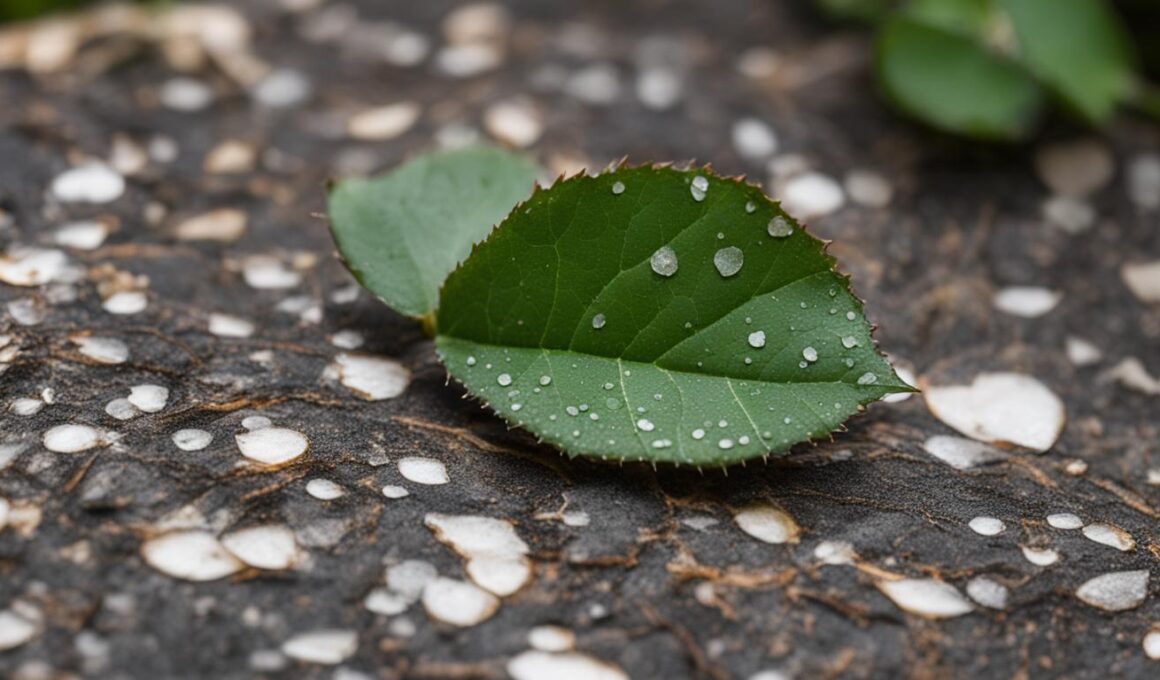If you’ve noticed white spots on your rose leaves, you may be wondering what’s causing them and how to fix the issue. White spots on rose leaves can be a sign of a fungal disease called powdery mildew. This common disease thrives in humid conditions and is characterized by a white powdery residue on the leaves. Not only does powdery mildew mar the beauty of your roses, but it can also cause the leaves to become crinkled and distorted.
Aside from powdery mildew, there are several other factors that can contribute to the development of white spots on rose leaves. Planting roses too close together can limit airflow around the plants and create a favorable environment for powdery mildew to thrive. Additionally, watering the leaves in the evening can create a humid environment, which further increases the risk of powdery mildew.
To fix the issue of white spots on rose leaves, there are several steps you can take. Firstly, it is recommended to prune the affected leaves and dispose of them properly. This will help prevent the spread of the disease to other parts of the plant. Secondly, providing proper spacing between your rose plants is important to ensure good air circulation. This will help reduce the humidity around the plants and make it less favorable for powdery mildew to develop.
In addition to pruning and spacing, using preventative treatments can also help control powdery mildew. One effective treatment is to spray the affected plants with a mixture of baking soda and water. The alkaline properties of baking soda can inhibit the growth of powdery mildew. Alternatively, you can use fungicides that are specifically labeled for powdery mildew control on roses.
By taking these steps and implementing preventative measures, you can effectively address the issue of white spots on your rose leaves and keep your plants healthy and beautiful.
Prevention and Maintenance Tips for Powdery Mildew
To prevent powdery mildew on rose leaves, it is important to practice good garden hygiene. Follow these tips to keep your roses healthy and free from this fungal disease:
- Choose a suitable location for planting roses, such as an area with full sun and good air circulation. This will help create an environment less favorable for powdery mildew to thrive.
- Proper soil management is crucial. Ensure good drainage by improving the soil structure and adding organic matter. Water the roses regularly, especially during dry periods, to keep the plants healthy and better able to resist powdery mildew.
- Prune your rose shrubs to give them an open structure. This allows for better air circulation, reducing the chances of powdery mildew development.
- Avoid overhead watering, especially in the morning or evening. Wet rose leaves create a humid environment that is ideal for powdery mildew growth. Instead, water at the base of the plants.
- If powdery mildew does occur, take immediate action. Remove any affected leaves carefully and dispose of them in a sealed bag to prevent the spread of spores.
- For a natural and effective solution, create a baking soda spray by mixing 1 tablespoon of baking soda with 1 gallon of water. Spray the solution on the rose leaves, covering both sides. This can help control and reduce the spread of powdery mildew.
Take a proactive approach by regularly spraying the baking soda solution throughout the growing season. This will help prevent the disease from spreading and protect your rose leaves from being affected by powdery mildew.
Chemical Control for Rose Powdery Mildew
If preventative measures are not effective in controlling powdery mildew on rose leaves, chemical control options can be considered. Fungicides such as sulphur, tebuconazole, and triticonazole are labeled for the control of rose powdery mildew and can be used to treat infected plants. There are also products available that contain a combination of insecticide and fungicide, offering control for both invertebrates and diseases.
When using chemical controls, it is important to follow the instructions provided with the product and use them in a minimal and highly targeted manner. Applying fungicides in late winter or early spring as a preventative measure and making several applications throughout the growing season, particularly in humid weather, is recommended for optimal results.
To effectively implement chemical control for rose powdery mildew:
- Identify the presence of powdery mildew on rose leaves.
- Choose an appropriate fungicide labeled for rose powdery mildew control.
- Read and follow the instructions on the fungicide label carefully.
- Apply the fungicide in late winter or early spring as a preventative measure.
- Make several applications throughout the growing season, especially during periods of high humidity.
Using chemical controls in a targeted manner helps minimize any potential harm to beneficial insects and the environment. It is crucial to maintain proper safety precautions while handling and applying fungicides, ensuring they are kept out of the reach of children and pets.
Are White Spots on Rose Leaves and Pepper Plant Leaves Curling Related Plant Health Issues?
Yes, white spots on rose leaves and pepper plant leaves curling are related plant health issues. These symptoms can be caused by fungal diseases such as powdery mildew, which can affect both roses and pepper plants. Proper care, including ensuring good air circulation and regular inspection, can help prevent and manage these issues.
Conclusion
White spots on rose leaves are often a sign of powdery mildew, a fungal disease that thrives in humid conditions. To prevent powdery mildew, it is important to implement preventative measures such as proper spacing, good air circulation, and regular pruning. By giving your rose plants adequate room to breathe and removing any overcrowded branches, you can significantly reduce the risk of powdery mildew.
If powdery mildew does occur on your rose leaves, there are treatment options available. Pruning affected leaves can help control the spread of the disease and prevent further damage to your plants. Additionally, spraying a mixture of baking soda and water on the affected leaves can be an effective natural remedy to control powdery mildew. This solution alters the pH level on the leaf surface, creating an environment that is less favorable for the growth of the fungus.
In more severe cases, chemical controls can be used as a last resort. Fungicides labeled for powdery mildew control, such as sulphur, tebuconazole, and triticonazole, can be applied to treat infected plants. It is important to follow the instructions provided with the product and use them in a minimal and highly targeted manner. Regular application of fungicides throughout the growing season, particularly in humid weather, can help keep powdery mildew at bay.
In conclusion, with proper prevention and care, you can enjoy beautiful, white spot-free roses. Ensure your rose plants have adequate spacing, good airflow, and regular pruning. If powdery mildew does occur, take prompt action by pruning affected leaves and using a baking soda solution. If necessary, resort to chemical control options as a last resort. By following these steps, you can effectively manage powdery mildew and maintain the health and beauty of your rose plants.









